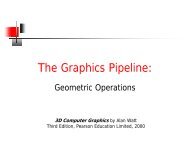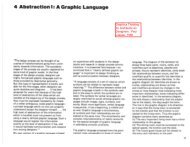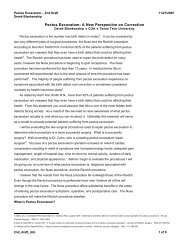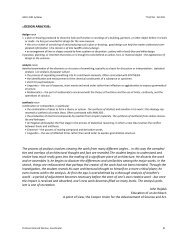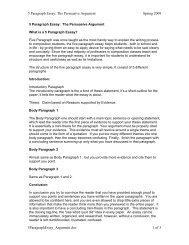The Eyes of the Skin
The Eyes of the Skin
The Eyes of the Skin
Create successful ePaper yourself
Turn your PDF publications into a flip-book with our unique Google optimized e-Paper software.
'From television to newspapers,from advertising to all sorts <strong>of</strong> mercantileepiphanies, our society is characterised by a cancerous growth <strong>of</strong>vision, measuring everything by its ability to show or be shown, andtransmuting communication into a visual journey.,35 <strong>The</strong> cancerousspread <strong>of</strong> superficial architecturalimagery today, devoid <strong>of</strong> tectonic logicand a sense <strong>of</strong> materiality and empathy, is clearly part <strong>of</strong> this process.Oral versus Visual SpaceBut man has not always been dominateddominanceby vision. In fact, a primordial<strong>of</strong> hearing has only gradually been replaced by that <strong>of</strong> vision.Anthropological literature describes numerous cultures in which ourIprivate senses <strong>of</strong> smell, taste and touch continue to have collective importancein behaviour and communication. <strong>The</strong> roles <strong>of</strong> <strong>the</strong> senses in <strong>the</strong>utilisation <strong>of</strong> collective and personal space in various cultures was <strong>the</strong>subject matter <strong>of</strong> Edward T Hall's seminal book <strong>The</strong> Hidden Dimension,which, regrettably, seems to have been forgotten by architects.36 Hall'sproxemic studies <strong>of</strong> personal space <strong>of</strong>fer importantinsights into instinctualand unconscious aspects <strong>of</strong> our relation to space and our unconscioususe <strong>of</strong> space in behavioural communication.Hall's insight can serve as <strong>the</strong>basis for <strong>the</strong> design <strong>of</strong> intimate, bio-culturally functional spaces.Walter J Ong analyses <strong>the</strong> transition from oral to written culture and itsimpact on human consciousness and <strong>the</strong> sense <strong>of</strong> <strong>the</strong> collective in his bookOrality & Literacy. 37He points out that '<strong>the</strong> shift from oral to written speechwas essentially a shift from sound to visual space',38 and that 'printreplaced <strong>the</strong> lingering hearing-dominance in <strong>the</strong> world <strong>of</strong> thought andexpression with <strong>the</strong> sight-dominance which had its beginning in writing'. 39In Ong's view, '[t]his is an insistent world <strong>of</strong> cold, non-human facts'.4oOng analyses <strong>the</strong> changes that <strong>the</strong> shift from <strong>the</strong> primordial oral cultureto <strong>the</strong> culture <strong>of</strong> <strong>the</strong> written (and eventually <strong>the</strong> printed) word has causedon human consciousness, memory and understanding<strong>of</strong> space. He arguesthat as hearing-dominance has yielded to sight-dominance, situationalthinking has been replaced by abstract thinking. This fundamentalchangein <strong>the</strong> perception and understanding <strong>of</strong> <strong>the</strong> world seems irreversible to <strong>the</strong>writer: 'Though words are grounded in oral speech, writing tyrannicallylocks <strong>the</strong>m into a visual field forever ... a literate person cannot fullyrecover a sense <strong>of</strong> what <strong>the</strong> word is to purely oral people. '41In fact, <strong>the</strong> unchallengedhegemony <strong>of</strong> <strong>the</strong> eye may be a fairly recentphenomenon regardless <strong>of</strong> its origins in Greek thought and optics. InLucien Febvre's view: '<strong>The</strong> sixteenth century did not see first: it heard andsmelled, it sniffed <strong>the</strong> air and caught sounds. It was only later that it seriouslyand actively became engaged in geometry, focusing attention on <strong>the</strong>world <strong>of</strong> forms with Kepler (1571-1630) and Desargues <strong>of</strong> Lyon(1593-1662). It was <strong>the</strong>n that vision was unleashed in <strong>the</strong> world <strong>of</strong> scienceas it was in <strong>the</strong> world <strong>of</strong> physical sensations, and <strong>the</strong> world <strong>of</strong> beauty aswell.'42 Robert Mandrou makes a parallel argument: '<strong>The</strong> hierarchy [<strong>of</strong><strong>the</strong> senses] was not <strong>the</strong> same [as in <strong>the</strong> twentieth century] because <strong>the</strong> eye,which rules today, found itself in third place, behind hearing and touch,and far after <strong>the</strong>m. <strong>The</strong> eye that organises, classifies and orders was not<strong>the</strong> favoured organ <strong>of</strong> a time that preferred hearing. '43<strong>The</strong> gradually growing hegemony <strong>of</strong> <strong>the</strong> eye seems to be parallel with <strong>the</strong>development<strong>of</strong> Western ego-consciousness and <strong>the</strong> gradually increasingseparation <strong>of</strong> <strong>the</strong> self and <strong>the</strong> world; vision separates us from <strong>the</strong> worldwhereas <strong>the</strong> o<strong>the</strong>r senses unite us with it.Artistic expression is engaged with pre-verbal meanings <strong>of</strong> <strong>the</strong> world,meanings that are incorporated and lived ra<strong>the</strong>r than simply intellectuallyunderstood. In my vievv, poetry has <strong>the</strong> capacity <strong>of</strong> bringing usmomentarily back to <strong>the</strong> oral and enveloping world. <strong>The</strong> re-oralised word<strong>of</strong> poetry brings us back to <strong>the</strong> centre <strong>of</strong> an interior world. '<strong>The</strong> poetspeaks on <strong>the</strong> threshold <strong>of</strong> being,' as Gaston Bachelard notes,44 but it alsotakes place at <strong>the</strong> threshold <strong>of</strong> language. Equally, <strong>the</strong> task <strong>of</strong> art and architecturein general is to reconstruct <strong>the</strong> experience <strong>of</strong> an undifferentiatedinterior world, in which we are not mere spectators, but to which weinseparably belong. In artistic works, existential understanding arises24THE EYES OFTHE SKINPART I 2S






